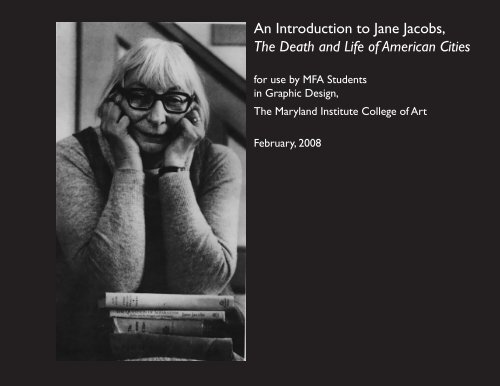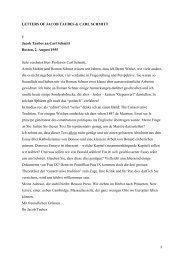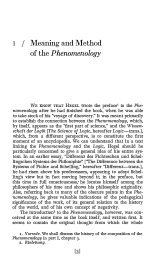An Introduction to Jane Jacobs, The Death and Life of American Cities
An Introduction to Jane Jacobs, The Death and Life of American Cities
An Introduction to Jane Jacobs, The Death and Life of American Cities
Create successful ePaper yourself
Turn your PDF publications into a flip-book with our unique Google optimized e-Paper software.
<strong>An</strong> <strong>Introduction</strong> <strong>to</strong> <strong>Jane</strong> <strong>Jacobs</strong>,<br />
<strong>The</strong> <strong>Death</strong> <strong>and</strong> <strong>Life</strong> <strong>of</strong> <strong>American</strong> <strong>Cities</strong><br />
for use by MFA Students<br />
in Graphic Design,<br />
<strong>The</strong> Maryl<strong>and</strong> Institute College <strong>of</strong> Art<br />
February, 2008
<strong>Jane</strong> <strong>Jacobs</strong> in 6 words:<br />
<strong>Jacobs</strong> loves sidewalks . . .<br />
. . . . <strong>and</strong> hates parks.
Let’s try that again:<br />
<strong>Jane</strong> <strong>Jacobs</strong> wants <strong>to</strong> res<strong>to</strong>re dignity <strong>to</strong><br />
streets <strong>and</strong> sidewalks by underst<strong>and</strong>ing<br />
the kinds <strong>of</strong> activity <strong>and</strong> relationships they<br />
support,<br />
while re-evaluating parks <strong>and</strong> open space,<br />
including their dependence on streets <strong>and</strong><br />
sidewalks for their vitality, interest, <strong>and</strong><br />
safety.
JANE JACOBS<br />
:: Born in Scran<strong>to</strong>n, Pennsylvania, 1916<br />
:: Moved <strong>to</strong> Greenwich Village in New York City,<br />
1928<br />
:: Associate edi<strong>to</strong>r <strong>of</strong> Architectural Forum, 1952<br />
:: She wrote <strong>The</strong> <strong>Death</strong> <strong>and</strong> <strong>Life</strong> <strong>of</strong> <strong>American</strong> <strong>Cities</strong>,<br />
1961<br />
:: In 1962, she was Chairperson <strong>of</strong> the Joint<br />
Committee <strong>to</strong> S<strong>to</strong>p the Lower Manhattan<br />
Expressway.<br />
:: Protesting the Vietnam War, she <strong>and</strong> her family<br />
emigrated <strong>to</strong> Toron<strong>to</strong>, Canada in1968, where she<br />
continued <strong>to</strong> work as an urban activist.<br />
:: She died in Toron<strong>to</strong>, in 2006 at the age <strong>of</strong> 90.
THE RADIANT GARDEN CITY BEAUTIFUL:<br />
or, what <strong>Jane</strong> JACOBS hates about<br />
urban planning<br />
In the opening sentence <strong>of</strong> <strong>The</strong> <strong>Death</strong> <strong>and</strong> <strong>Life</strong> <strong>of</strong> Great <strong>American</strong> <strong>Cities</strong>, <strong>Jane</strong> <strong>Jacobs</strong><br />
declares war on the major schools <strong>of</strong> urban planning:<br />
“This book is an attack on current city planning <strong>and</strong> rebuilding. It is also, <strong>and</strong><br />
mostly, an attempt <strong>to</strong> introduce new principles <strong>of</strong> city planning <strong>and</strong> rebuilding,<br />
different <strong>and</strong> even opposite from those now taught in everything from schools<br />
<strong>of</strong> architecture <strong>and</strong> planning <strong>to</strong> the Sunday supplements <strong>and</strong> women’s<br />
magazines.<br />
She names three major targets <strong>of</strong> urban planning.<br />
:: the Garden City<br />
:: the Radiant City<br />
:: the City Beautiful.<br />
Learn about each one on the slides that follow.
THE GARDEN CITY<br />
Ebenezer Howard, 1850-1928<br />
:: traveled in America<br />
:: a reformer appalled by the living<br />
conditions <strong>of</strong> London’s poor
Scenes <strong>of</strong> the London slum life that<br />
appalled Howard. Major problems included<br />
overcrowding, disease, filth, <strong>and</strong> crime.<br />
LONDON “SLUM”: Market Court, Kensing<strong>to</strong>n. Demolished late 1860s.<br />
http://www.vic<strong>to</strong>rianweb.org/art/architecture/london/56.html
LONDON SLUM: c. 1901?<br />
http://www.vic<strong>to</strong>rianlondon.org/houses/slums.htm
Ebenezer Howard<br />
<strong>The</strong> Three Magnets<br />
Howard’s “magnet” compares the attractions<br />
<strong>of</strong> <strong>to</strong>wn <strong>and</strong> country, <strong>and</strong> suggests a synthesis in<br />
the ideal <strong>of</strong> a Garden City.<br />
<strong>Jacobs</strong> writes,<br />
“Howard set spinning powerful <strong>and</strong> citydestroying<br />
ideas. He conceived that the way<br />
<strong>to</strong> deal with the city’s functions was <strong>to</strong> sort<br />
<strong>and</strong> sift out <strong>of</strong> the whole certain simple uses,<br />
<strong>and</strong> <strong>to</strong> arrange each <strong>of</strong> these in relative selfcontainment.<br />
He focused on the provision <strong>of</strong><br />
wholesome housing as the central problem,<br />
<strong>to</strong> which everthing else was subsidiary;<br />
furthermore he defined wholesome housing in<br />
terms only <strong>of</strong> suburban physical qualities <strong>and</strong><br />
small-<strong>to</strong>wn social qualities... He conceived <strong>of</strong><br />
good planning as a series <strong>of</strong> static acts; in each<br />
case, the plan must anticipate all that is neeeded<br />
<strong>and</strong> be protected, after it is built, against any but<br />
the most minor subsequent changes.”
Letchworth Garden City, north <strong>of</strong> London,<br />
is the “first planned city.”<br />
Letchworth Garden City, built in order <strong>to</strong><br />
demonstrate Howard’s ideas, became the model<br />
for a bunch <strong>of</strong> “New Towns” <strong>and</strong> “Garden<br />
<strong>Cities</strong>” in Engl<strong>and</strong> <strong>and</strong> the United States,<br />
including:<br />
Chatham Village (Pittsburgh)<br />
Garden City, New York<br />
Baldwin Hills Village, Los <strong>An</strong>geles
REMEMBER LEWISH MUMFORD<br />
LEWIS MUMFORD<br />
1895-1990
Like a construction gang bulldozing a site clean<br />
<strong>of</strong> all habitations, she bulldozes out <strong>of</strong> existence<br />
every desirable innovation in urban planning<br />
during the last century <strong>and</strong> every competing<br />
idea, without even a pretense <strong>of</strong> critical<br />
evaluation. ..<strong>The</strong> <strong>Death</strong> <strong>and</strong> <strong>Life</strong> <strong>of</strong> <strong>American</strong><br />
<strong>Cities</strong> is a mingling <strong>of</strong> sense <strong>and</strong> sensibility, <strong>of</strong><br />
mature judgments <strong>and</strong> school girl howlers.<br />
-- Lewis Mumford, from review <strong>of</strong> <strong>The</strong> <strong>Death</strong><br />
<strong>and</strong> <strong>Life</strong> <strong>of</strong> Great <strong>American</strong> <strong>Cities</strong>, 1961
THE RADIANT CITY<br />
Le Corbusier, 1887-1965
“Suppose we are entering the city<br />
by way <strong>of</strong> the Great Park. Our fast<br />
car takes the special elevated mo<strong>to</strong>r<br />
track between the majestic sky<br />
scrapers; as we approach nearer,<br />
there is seen the repetition against<br />
the sky <strong>of</strong> the 24 skyscrapers; <strong>to</strong><br />
our left <strong>and</strong> right on the outskirts<br />
<strong>of</strong> each particular area are the<br />
municipal <strong>and</strong> administrative<br />
buildings; <strong>and</strong> enclosing the space<br />
are the museums <strong>and</strong> university<br />
buildings. <strong>The</strong> whole city is a Park.”<br />
-- Le Corbusier on the Radiant City,<br />
cited by <strong>Jane</strong> <strong>Jacobs</strong>, p. 21.
frame <strong>of</strong><br />
furniture<br />
outside<br />
CORBU:<br />
not just<br />
buildings<br />
“cushion basket” designed by<br />
Le Corbusier, Charlotte Peri<strong>and</strong>, <strong>and</strong><br />
Pierre Jeanneret, 1928<br />
chaise lounge, 1928<br />
sling chair, 1928
http://www.queensmuseum.org/qmail/2007_02/images/rmoses.<br />
jpg<br />
ROBERT MOSES, 1888-1981<br />
Robert Moses brought the Radiant<br />
City <strong>to</strong> New York. His vision <strong>of</strong><br />
the modernized city included<br />
expressways that encouraged a car<br />
culture <strong>of</strong> commuting in <strong>and</strong> out <strong>of</strong><br />
New York. His highways disrupted<br />
many traditional working class<br />
neighborhoods. <strong>Jacobs</strong> was one <strong>of</strong><br />
his fiercest opponents.
Robert Moses returns <strong>Jacobs</strong>’ book <strong>to</strong> R<strong>and</strong>om House.<br />
I found it at http://www.blog.sethroberts.net/2008/02/15/introductions-<strong>to</strong>-jane-jacobscccibcontinued/#comments
JANE JACOBS MEETS ROBERT MOSES<br />
(or, a little Pho<strong>to</strong>shop is a dangerous thing.)
World’s Fair, Chicago 1893<br />
CITY BEAUTIFUL:<br />
<strong>The</strong> World’s Fair<br />
Approach<br />
<strong>to</strong> Urban Planning
JANE JACOBS ON THE WORLD’S FAIR<br />
“One heavy, gr<strong>and</strong>iose monument after another<br />
was arranged in the exposition park, like frosted<br />
pastries on a tray, in a sort <strong>of</strong> squat,<br />
decorative forecast <strong>of</strong> Le Corbusier’s later<br />
repetitive ranks <strong>of</strong> <strong>to</strong>wers in a park. This<br />
orgiastic assemblage <strong>of</strong> the rich <strong>and</strong> monumental<br />
captured the imagination <strong>of</strong> both planners <strong>and</strong><br />
public. It gave impetus <strong>to</strong> a movement called the<br />
City Beautiful ... <strong>The</strong> aim <strong>of</strong> the City Beautiful<br />
was the City Monumental, modeled on the<br />
fair. City after city built its civic center or its<br />
cultural center. ... However they were arranged,<br />
the important part was that the monuments<br />
had been sorted out from the rest <strong>of</strong> the city,<br />
<strong>and</strong> assembled in<strong>to</strong> the gr<strong>and</strong>est effect thought<br />
possible, the whole being treated as a unit, in a<br />
separate <strong>and</strong> well-defined way.”<br />
(<strong>Death</strong> <strong>and</strong> <strong>Life</strong>, p. 24)
THE MALL, Washing<strong>to</strong>n, DC<br />
http://www.som.com/content.cfm/washing<strong>to</strong>n_mall_<strong>and</strong>_constitution_gardens<br />
Bicentenniel renovations, by Skidmore, Owings <strong>and</strong> Merrill, 1976.
THE MALL, take two:<br />
.... at LEGOLAND.<br />
Can you find the<br />
specta<strong>to</strong>rs at the edges<br />
<strong>of</strong> this “model city”?
VERY DIFFERENT<br />
MODELS<br />
:: garden suburbs<br />
:: modernist<br />
skylines<br />
:: theme park<br />
down-<strong>to</strong>wns<br />
“<strong>The</strong> Decentrists ... were aghast<br />
at Le Corbusier’s city <strong>of</strong> <strong>to</strong>wers in<br />
the park... <strong>An</strong>d yet, ironically, the<br />
Radiant City comes directly out<br />
<strong>of</strong> the Garden City. Le Corbusier<br />
accepted the Garden City’s<br />
fundamental image, superficially<br />
at least, <strong>and</strong> worked <strong>to</strong> make it<br />
practical for high densities. “<strong>The</strong><br />
solution will be found in the<br />
‘vertical garden city.”<br />
(JJ, 22)
What they share:<br />
:: dislike <strong>of</strong> traditional urban density<br />
<strong>and</strong> diversity<br />
:: desire <strong>to</strong> sort out urban functions<br />
:: transfer <strong>of</strong> park <strong>and</strong> <strong>to</strong>wn model<br />
<strong>to</strong> city living<br />
:: well-intentioned reformers <strong>and</strong><br />
intellectuals
ubiqui<strong>to</strong>us: from Latin<br />
ubique, everywhere<br />
What <strong>Jane</strong> proposes:<br />
:: <strong>to</strong> counter the myth <strong>of</strong> the city (city as garden)<br />
:: with the reality <strong>of</strong> cities (“how cities work in real<br />
life,” p. 4)<br />
“One principle emerges ubiqui<strong>to</strong>usly... This ubiqui<strong>to</strong>us<br />
principle is the need <strong>of</strong> cities for a most intricate <strong>and</strong><br />
close-grained diversity <strong>of</strong> uses that give each other<br />
constant mutual support, both economically <strong>and</strong><br />
socially... Unsuccessful city areas are areas which lack<br />
this kind <strong>of</strong> intricate mutual support.” (p. 14)
Note J.J.’s attention <strong>to</strong><br />
patterns, contexts, <strong>and</strong><br />
systems <strong>of</strong> use <strong>and</strong><br />
meaning.<br />
“A sidewalk by itself is nothing.<br />
It is an abstraction. It means<br />
something only in conjunction<br />
with the buildings <strong>and</strong> other uses<br />
that border it, or border other<br />
sidewalks very near it.” (p. 29)<br />
Relationships:<br />
~ sidewalk<br />
~ buildings<br />
~ street
Turning. Pho<strong>to</strong> by Markus Hartel.<br />
http://www.markushartel.com/blog/about/about-street-pho<strong>to</strong>graphy.html<br />
SIDEWALKS AND SAFETY<br />
In Chapter Two, <strong>Jacobs</strong> argues that<br />
a properly functioning sidewalk is<br />
a deterrent against crime. A busy<br />
sidewalk, used day <strong>and</strong> night by<br />
different populations on their way<br />
<strong>to</strong> work, home or leisure, checks<br />
crime. Meanwhile, proprie<strong>to</strong>rs <strong>and</strong><br />
neighbors, situated close <strong>to</strong> the<br />
ground, provide “eyes upon the<br />
street,” a citizen surveillance system<br />
that builds trust, not destroys it.
Dearborn Homes, Chicago.<br />
http://tigger.uic.edu/depts/ahaa/imagebase/maclean/aerials3/089.JPEG<br />
THE PROBLEM WITH PROJECTS<br />
Projects are turned inward on<strong>to</strong><br />
courtyards, away from streets <strong>and</strong><br />
sidewalks.<br />
<strong>The</strong>re is little commerce or street<br />
life <strong>to</strong> keep “eyes on the street.”<br />
<strong>The</strong> lack <strong>of</strong> sidewalks leads <strong>to</strong><br />
“Turf”:<br />
:: gang warfare by the poor<br />
:: fortressing by the wealthy
Period <strong>of</strong> Time. Pho<strong>to</strong> by Markus Hartel.<br />
http://www.markushartel.com/blog/sidewalk/period-<strong>of</strong>-time.html<br />
SIDEWALK BALLET<br />
Chapter Two ends with Jacob’s<br />
account <strong>of</strong> a day on Hudson Street,<br />
staged as “an intricate sidewalk<br />
ballet.” <strong>The</strong>se pages constitute<br />
the most quoted <strong>and</strong> anthologized<br />
section <strong>of</strong> the book. <strong>Jacobs</strong> writes,<br />
“It is a complex order. Its essence<br />
is intricacy <strong>of</strong> sidewalk use, bringing<br />
<strong>to</strong> it a constant succession <strong>of</strong> eyes.<br />
This order is all composed <strong>of</strong><br />
movement <strong>and</strong> change, <strong>and</strong> although<br />
it is life, not art, we may fancifully<br />
call it the art form <strong>of</strong> the city <strong>and</strong><br />
liken it <strong>to</strong> the dance ...” (50-54).
Summer, the Lower East Side. Pho<strong>to</strong> by Weegee,<br />
1937.<br />
http://museum.icp.org/museum/collections/special/weegee/<br />
SIDEWALK BALLET<br />
an invitation <strong>to</strong> OBSERVE<br />
(the practice <strong>of</strong> urban pho<strong>to</strong>graphy)
SIDEWALK BALLET<br />
an invitation <strong>to</strong> DANCE<br />
(urban ballet, street dancing,<br />
percussion musicals)
SIDEWALK BALLET<br />
an invitation <strong>to</strong> READ AND WRITE<br />
(books <strong>and</strong> blogs about urbanism,<br />
urban fiction written from the<br />
streets)
Banksey, the Albert Pub, Brigh<strong>to</strong>n.<br />
http://www.bbc.co.uk/southerncounties/content/image_galleries/<br />
brigh<strong>to</strong>n_graffiti_gallery.shtml?28<br />
SIDEWALK BALLET<br />
an invitation <strong>to</strong> ART AND DESIGN
“Conventionally,<br />
neighborhood parks or<br />
parklike open spaces<br />
are considered boons<br />
conferred on the<br />
deprived populations <strong>of</strong><br />
cities.<br />
CHAPTER FIVE<br />
<strong>The</strong> Uses <strong>of</strong> Neighborhood Parks<br />
<strong>Jacobs</strong> opens her chapter on<br />
parks by turning common planning<br />
wisdom upside down:<br />
Let us turn this thought<br />
around, <strong>and</strong> consider city<br />
parks deprived places<br />
that need the boon <strong>of</strong><br />
life <strong>and</strong> appreciation<br />
conferred on them.”<br />
(p. 88)
Rittenhouse Square, Philadelphia<br />
“Rittenhouse Square<br />
possesses a diverse<br />
rim <strong>and</strong> diverse<br />
neighborhood<br />
hinterl<strong>and</strong>. ... This<br />
mixture <strong>of</strong> uses <strong>of</strong><br />
buildings directly<br />
produces for the park<br />
a mixture <strong>of</strong> users<br />
who enter <strong>and</strong> leave<br />
the park at different<br />
times ... <strong>The</strong> park thus<br />
possesses an intricate<br />
sequence <strong>of</strong> uses <strong>and</strong><br />
users.” (p. 96)
A thesis is born: <strong>Jane</strong> <strong>Jacobs</strong> on Making<br />
<strong>Jane</strong> <strong>Jacobs</strong> is not herself a maker.<br />
In fact, she maps the limits <strong>of</strong> making<br />
-- the limits, that is, <strong>of</strong> our ability <strong>to</strong><br />
engineer our environments in order<br />
<strong>to</strong> shape human behavior.<br />
She is not, however, telling us<br />
<strong>to</strong> ab<strong>and</strong>on our designs. Rather,<br />
she leaves us with the following<br />
challenge:<br />
How can our acts <strong>of</strong> making become more effective<br />
by working with rather than against human patterns<br />
<strong>of</strong> use <strong>and</strong> interaction, elaborating forms <strong>of</strong> life <strong>and</strong><br />
knowledge embedded in urban environments ?
SUMMARY<br />
One <strong>of</strong> the truisms <strong>of</strong> orthodox planning is the idea that parks <strong>and</strong> open<br />
space are in <strong>and</strong> <strong>of</strong> themselves healthy, positive additions <strong>to</strong> urban <strong>and</strong><br />
suburban life – genuine <strong>and</strong> inarguable improvements over the asphalt<br />
<strong>and</strong> concrete <strong>of</strong> urban streets <strong>and</strong> sidewalks.<br />
<strong>Jacobs</strong> “turns this idea around” by suggesting that it is cities (their<br />
activity, their density, the interest that they bring in the form <strong>of</strong> foot<br />
traffic, the enclosure they provide by way <strong>of</strong> buildings <strong>and</strong> streets) that<br />
make parks successful. <strong>The</strong> lack <strong>of</strong> sufficient city life renders parks both<br />
dull <strong>and</strong> dangerous.<br />
It is not quite fair <strong>to</strong> say that “<strong>Jane</strong> <strong>Jacobs</strong> loves sidewalks <strong>and</strong> hates<br />
parks,” but it’s a good place <strong>to</strong> start. Read her book with the tension<br />
between sidewalks (traditional cities) <strong>and</strong> parks (garden cities) in mind.<br />
<strong>An</strong>d think about its resonances for design. Where’s the sidewalk?<br />
Where’s the park?




